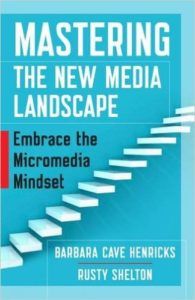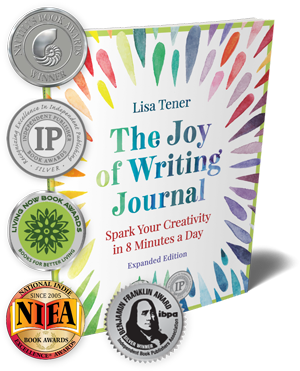 Twitter for Authors? Here’s Your Go-to Expert.
Twitter for Authors? Here’s Your Go-to Expert.
I first met Rusty Shelton before Twitter existed – for authors or anyone. We met when my book, The Ultimate Guide to Transforming Anger came out over a decade ago. Rusty’s approach to book publicity was so far beyond anything else out there. And the personal attention he and his colleagues gave our book was far superior to the boilerplate template we received from other book publicists as we looked for someone we could trust with “our baby.”
Throughout my career, Rusty and his companies, Shelton Interactive, Advantage Marketing, and now Zilker Media, have guided me and supported my career in innumerable ways: from recommending me as a faculty member for Harvard Medical School’s publishing course to garnering an invitation to guest post for Writer’s Digest to advising me all along the way.
His book, co-authored with Barbara Cave Henricks, Mastering the New Media Landscape is a must-read for authors and entrepreneurs. You’ll find Rusty’s strategic perspective in every chapter. He has helped more books get on the New York Times Bestseller List than any publicist or digital media strategist I know.
[bctt tweet=”What Twitter Can Do for Authors” username=”LisaTener”]
Lisa: Why is Twitter such an important “space” for authors to be?
Rusty: There is no better social platform to build intentional, outbound relationships with journalists, groups, conferences and other influencers. As counter-intuitive as it may seem, Twitter allows an author (when they approach it the right way) to get above the noise found in the media’s inbox and connect on a peer to peer level.

Lisa: What kinds of big picture goals should authors have for Twitter? What can it do for them?
Rusty: The primary goal of Twitter is to use it to build relationships with the following groups:
- the top 50 journalists/bloggers/media members in your topic area (make a list and tweet to someone on this list at least 1x a day)
- the top 50 influencers/authors/experts/
authorities in your topic area (make a list and tweet to someone on this list at least 1x a day) - the top 50 groups/organizations/
conferences/associations/ businesses you want to build relationships with (make a list and tweet to someone on this list at least 1x a day)
Additionally, Twitter gives you a great platform to thank people who help you with your book launch and to connect with readers who talk about your book. A public shout-out on Twitter is much more powerful than a private email.
Twitter Authors’ Success Stories
Lisa: The instructions remind me of the story of the success of the original Chicken Soup for the Soul. As I heard it, Jack Canfield and Mark Victor Hanson did one thing for their book every day. This sounds like the modern version of that and something that can elevate the success of an author in an organic and authentic way. Do you have some examples of goals your clients had and met on Twitter?
 Rusty: One of my favorite stories is that of Carol Sanford. A successful speaker and consultant to international corporations like Colgate, Seventh Generation, and DuPont, Carol came to me skeptical about how Twitter could improve her platform. She hired us to help launch her first book, The Responsible Business. After putting four years of her life into writing that book, she wanted to make sure she left no stone unturned when it came to marketing. She knew the importance of coverage from traditional outlets like Bloomberg Businessweek, CNBC-TV, and other major players. Yet, as someone who came of age before the massive changes and disruption in the media, Twitter was not on her radar.
Rusty: One of my favorite stories is that of Carol Sanford. A successful speaker and consultant to international corporations like Colgate, Seventh Generation, and DuPont, Carol came to me skeptical about how Twitter could improve her platform. She hired us to help launch her first book, The Responsible Business. After putting four years of her life into writing that book, she wanted to make sure she left no stone unturned when it came to marketing. She knew the importance of coverage from traditional outlets like Bloomberg Businessweek, CNBC-TV, and other major players. Yet, as someone who came of age before the massive changes and disruption in the media, Twitter was not on her radar.
Despite her skepticism, we were able to convince her to give Twitter a try. Within a few weeks, Carol had mastered the basics of Twitter, and we had developed a strategy to build relationships with journalists and key influencers in her topic area using her new Twitter skills. As a new—and relatively unknown—author, Carol needed to mine every opportunity to connect with influential people, and Twitter offered her that chance.
Almost immediately, Carol connected with Sam Ford, a popular blogger at Fast Company. Sam had written a post that Carol loved, and she retweeted his tweet about the post, adding a personalized comment.
Carol was drawn to Sam’s unique approach to blogging, by the way, as he used soap operas to illustrate various business situations. This caught Carol’s eye and prompted her to praise his originality. Sam, like many journalists, kept a close eye on his Twitter account and thanked Carol for her comment. From there, the two started a conversation on Twitter about what it truly means to be a responsible business. The connection was made, and when Carol’s book released six months later, the cover featured Sam’s endorsement. He even invited her to speak at a few business events, and forged a personal friendship as well.
Were it not for Twitter, Carol and Sam were unlikely to have ever connected. But Carol’s story didn’t end there. Based on a continued focus on using rented media (in her case, Twitter) to build relationships with key targets, Carol self-generated coverage in Inc. magazine; appeared at a Fast Company conference; hosted a conference at Vault, an event space showcasing cutting-edge ideas; and was invited to do some consulting work with Google where we had nailed down a book talk for her.
She recalls her comment when we first brought up the importance of rented media, “I thought Twitter was just shallow. Not substantive, at best, and at worst, a place to celebrity watch. What I found was some of the most interesting thinkers in the world. And, being an introvert, I am not at all sure I could have connected with them any other way.”
[bctt tweet=”Twitter Tips for Authors” username=”LisaTener”]
Lisa: Wow, what a testament to what’s possible when you take Twitter seriously, spend time on Twitter and authentically respond to what you see there, particularly when you find a fresh voice that resonates for you. What are some of the things you advise your clients to do when they first get on Twitter?
Rusty: The first thing to do is build your a quality profile. I can’t tell you how many people I see sign up for Twitter and not post a quality bio, well-designed header image or even an avatar picture. This Twitter account is going to be become a key first impression for many people – make sure it’s a good one.
Secondly, Twitter is all about focus. Many people call it the world’s biggest cocktail party, which I think is the perfect analogy. Just like cocktail parties, people circle up in small groups on Twitter talking about an infinite amount of topics. Some talk about House of Cards, others the election and so on. You don’t want to just wander around this cocktail party or you’ll never get anywhere. The crucial step here: build the three lists I described above and focus at least 75% of your content on those lists.
Authors: Avoid These Twitter Trip-Ups
Rusty: Me-first content is by far the biggest and most common mistake I see on Twitter. If more than 10% of your content benefits you (links to your book, promotional content, etc.) you’re the person no one wants to talk to at the cocktail party.
The other mistake I see is when authors proactively pitch themselves to journalists on Twitter. Your goal in relationship-building on the platform isn’t a direct pitch to them – it’s pulling them to you by talking to them like a peer. In other words, instead of saying “Hi @DavidSmith – loved your column in the @WSJ today. I’d like to interview with you on that topic next time” say something along the lines of “Really interesting piece from @DavidSmith in the @WSJ today. Love his unique angle on neuroplasticity – don’t see that much.”
You want the journalist to find your tweet interesting and on-topic enough to click through and look at your bio and (hopefully) then click through to your website.
Authors: Track Your Twitter
Lisa: What are some benchmarks authors might use to evaluate how they are doing with Twitter?
Rusty: These are the benchmarks that we track for our Members/Clients on Twitter:
- Engagement (how many people engage with your content? This could include likes, responses and retweets)
- Reach (how many impressions are you getting on Twitter?)
- Results (how many media hits, speaking invites and other ‘offline’ results have been generated?)
- Followers (this is what everyone focuses on but it’s much less important than impact)
Updated bio (2022): Rusty Shelton is Founder and President of Zilker Media. He is co-author of Mastering the New Media Landscape: Embrace the Micromedia Mindset. Visit Rusty’s website for a free copy of The Twitter Playbook.
Have a question about Twitter for authors? Ask as a comment below. Or share your insights about the benefits of Twitter for authors. Share your tips, too.
And here are the next two posts in the Social Media for Authors series:
- Frances’ Caballo shares her tips on Goodreads for Authors.
- Sara Pence shares why Guest Blogging is such an excellent strategy for authors–and how to guest blog successfully.



Thanks So Much for putting this together Lisa!
Rusty/Lisa – Couple of questions: (1) You mentioned “Twitter allows an author (when they approach it the right way)” to get above the noise…” What is the “right way” (e.g., being authentic as Lisa mentioned, or using a conversational approach as Rusty mentioned)? (2) You mentioned the importance of having a quality Twitter profile – In your experience what makes a profile stand out?
And, Lisa, great question about what benchmarks are useful to evaluate progress!
Appreciate all of the excellent tips! Makes Twitter seem much less intimidating!
Hi Denise –
Thanks so much for your questions!
1. What allows you to get above the noise is beginning a conversation with journalists, influencers and other targets on a peer to peer level. In other words, I don’t want you just retweeting or praising journalists. Instead, share a thought on a recent article they wrote. Ask what sparked their interest in that particular company or person. Essentially, I’d love for you to use a cocktail party filter on the conversation. Consider whether or not you would say it in person and whether or not the comment helps them to see you as a peer on that topic or a fan.
2. Good question here! The first thing that makes a Twitter profile stand out are quality pictures. Your avatar picture should be one that is sharp and builds credibility. Your header image (the large horizontal image) should be something that establishes your brand (perhaps you speaking on stage, an image of your book, etc.). The bio should make it clear who you are and what credentials you have. Don’t get too cute with it – I prefer titles, accomplishments divided by horizontal lines (|) so you can fit as much as possible and quickly show the journalist, influencer, etc you’ve been interacting with that you’re someone to pay attention to.
Thanks again,
Rusty
Appreciate you expanding on your expertise, Rusty! Gives me traction as I begin building my author platform.
Thanks, Denise. I’ve asked Rusty to respond and we should hear from him soon.
Thank-you, Lisa!
Can you give a few tips on finding the 3 groups of top 50 journalist/bloggers, influencers/authors, and organizations/conferences? How do you identify these important people/groups? Should I search particular topics, look for number of followers, or search in a different way?
Hi Julia –
This is a great question.
The best way to find the top 50 journalists/bloggers is to search on Google for “top business journalists on Twitter” or “top political bloggers on Twitter” (whatever your topic area may be). Often someone has already done the work for you and created a blog post or list that aggregates those journalists.
Same thing goes with influencers and organizations. Once you create the baseline list, you should be adding people to them each week as you see new people who fit those profiles.
Don’t worry about the number of followers that media and organizations have – worry more about their reach off of Twitter, as you’re looking to build a relationship that will drive results off the platform as much as on.
Thanks, Rusty. Julia, I found a list of top 100 personal development blogs. That might be a good start. Often, when you go to the blog, you can find their twitter handle by clicking on the twitter symbol. Looking at the list, not all of them are relevant to your field, but I think you will find several that are (and you won’t have to look them all up–you can rule many of them out from the names of the blogs). And “personal development” is just a starting place. You may identify other categories that could be even more fruitful.